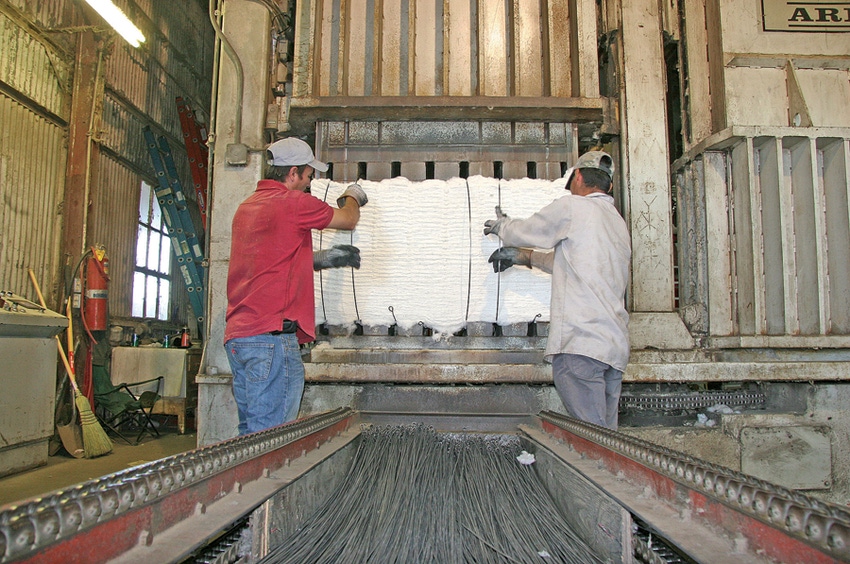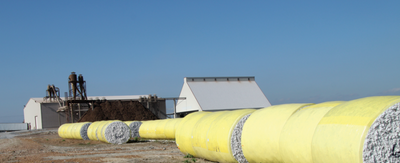
“While we’re continually hearing about the loss of ginning infrastructure, I don’t worry too much about the mechanics of this,” says Tommy Valco, USDA/ARS. “I think our gins are able to expand their capacity to handle pretty much whatever is thrown at them in terms of crop size. What I do worry about is gin personnel when cotton rebounds."

As the number of active U.S. cotton gins continues to contract, the challenge facing the industry may not be so much a loss of infrastructure as one of adequate labor when cotton acres rebound, says Tommy Valco.

TOMMY VALCO
“We’re going to continue to see more consolidation of gins,” he said at the annual meeting of the Southern Cotton Ginners Association, held in conjunction with the Mid-South Farm and Gin Show. He is USDA/ARS cotton technology transfer and education coordinator at the Jamie Whitten Delta States Research Center at Stoneville, Miss.
“We won’t have official numbers from the National Agricultural Statistics Service until May, but we’re estimating there were 660 active gins in 2013, with an average 20,000 bales ginned. That’s down from 2012, when we had 671 active gins, averaging 25,088 bales per gin.”
In 2012, there were 55 active gins in Arkansas and Mississippi and about 30 in Missouri, Louisiana, and Tennessee. “We’ve even had a few new gins built in recent years,” Valco says.
In the U.S. in 2012, 16.6 million bales were ginned; in 2013, that dropped to an estimated 12.5 million bales.
AG NEWS delivered daily to your inbox: Subscribe to Delta Farm Press Daily
“While we’re continually hearing about the loss of ginning infrastructure, I don’t worry too much about the mechanics of this,” he says. “I think our gins are able to expand their capacity to handle pretty much whatever is thrown at them in terms of crop size.
“What I do worry about is gin personnel. We just don’t have that many young people moving into the ginning sector. When cotton acres come back, we may face a struggle in finding qualified persons to run our gins.”
One of the key considerations in the industry, as gin numbers contract, is transportation. “The fewer gins, the further we have transport our cotton,” Valco says. “This is a trend that began in the 1970s when the module builder system came on the scene, and now with the round modules, cotton is being transported even longer distances for ginning.”
While planted cotton acres have declined dramatically in recent years, indications are there may be slight increases for 2014. Preliminary surveys show intended increases in Louisiana, Mississippi, and Tennessee, while Arkansas and Missouri will hold about steady at 2013 levels.
Concerns: higher mike, bark, plastic
Going into 2014, there are some continuing concerns for Mid-South cotton, Valco says.
“Over last couple of years, micronaire values have tended to move upward. In 2013, Louisiana averaged 5.0, Mississippi 4.7, and even Missouri was at 4.6. High micronaire cotton can only be used for certain products, and this restricts where our cotton can go.
“We need to continue working with our producers to select varieties that won’t fall into the discount range, but rather into the lower to medium micronaire range.”
Bark numbers are also up, Valco says, and “nobody knows for sure why. Bark is a serious problem for textile mills; it becomes very fibrous and causes blemishes in fabric. This is something for which we may have to compensate in the gin — maybe some additional cleaning, etc.”

PLASTIC and other contaminants in cotton can result in costly defects in finished goods.
Foreign matter and leaf grade have been increasing as well, he says. “Some of this is related to the hairy leaf cottons, which are more and more becoming varieties of choice. We’ve been working with Extension cotton specialists to develop a leaf hairiness index grade, to offer more information about this trait than seed companies have been providing.
“A technique was developed to measure hairs per centimeter, and it was found that this can vary considerably, not only by year, but by growth region. We saw a lot of variability in hairiness from region to region.”
There was some increase in stickiness last year in some of the cotton in the western U.S., he says, and it rarely is a problem in the Mid-South.
Contamination remains an issue for the industry, Valco says.
“The U.S. is known as the source of some of the most contaminant-free cotton in the world. This is a reputation we’ve worked hard to obtain. Unfortunately, we’ve been seeing more instances of plastic — shopping bags, mulch, etc. — getting into our bales of cotton.”
There has been, Valco says, “a learning curve” for gins and producers in the proper handling of round modules.
“When the John Deere 7760 picker came on the market, few could have foreseen just how fast this technology would sweep across the cotton belt. I’d estimate that nationally these round modules constitute 50 percent or more of our cotton, and here in the Mid-South and in the Southeast, that percentage would be even higher.
Plastic removal 'critically important'

ROUND MODULES now constitute more than half of modules ginned in the Mid-South.
“It has been a very effective system in terms of labor and energy savings for producers, but we’ve had a learning curve in handling these modules —burst wrappers, torn wrappers, and some cases of extra plastic getting into the ginning system.
“But I think we now have enough experience with this system that our gin workers are trained well enough to spot any of this plastic and get it out of the cotton before it gets into the gin.”
The key point, Valco says, is that gin owners/managers “need to see this as critically important and continue to be sure workers are trained to cut and remove these wrappers properly, and to be vigilant in watching for plastic contaminants so they can remove them.”
The National Cotton Council, the National Cotton Ginners Association, and Cotton Incorporated developed a brochure to instruct gin workers on the proper method of cutting wrappers and removing them, he says.
A number of ginning research projects were reported on at the Beltwide Cotton Conferences, Valco says. Among them:
• Gin saw tooth design performance: “This is aimed at determining the optimum design to remove lint efficiently while maintaining quality and productivity.”
• Pneumatic-type lint cleaners, which have no saws and grid bars, using air alone to remove trash from cotton.
• Microwave drying systems for improving drying efficiency and reducing energy use.
• Cotton moisture measurement: Work has been under way for many years to develop technology to measure cotton moisture and to evaluate the measuring devices available from commercial sources. The accuracy of cotton bale moisture measurement devices is the focus of ongoing research.
• Energy monitoring in gins — identifying the voltage and amperage being used by each motor in order to determine additional ways to reduce energy use.
• The effect of seed cotton cleaner speed: How to move more bales per hour through the ginning system while removing more trash.
In spring 2013, Valco says, a survey was conducted on research needs for the ginning industry. “The top three needs were research on automation and labor, production and processing costs, and moisture management and drying systems. Other suggestions were quality, trash, contamination, safety, and energy.”
Soon to be conducted, he says, will be a survey on ginning costs. “Our last survey was in 2010, and we need an update. The data we collect from this survey is very useful to ginners and farmers in helping to improve their operations and get a better product.”
About the Author(s)
You May Also Like



